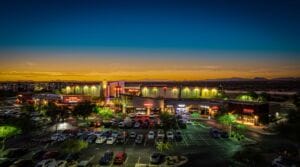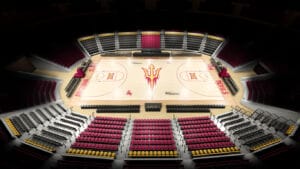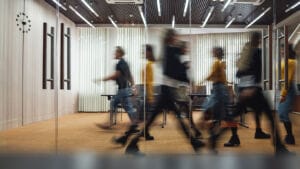It takes time for a landmark project to be considered a core asset. Its prestige and value are first-and-foremost retained over time and compounded by reliable appreciation.
Since first opening, core assets across the Valley have increased in value and demand, but current owners are now finding it time to re-imagine what it means to be a core asset in order to ensure relevancy given the competition and demands of today’s target tenants.
“In order for a core asset to stay a core asset, reinvestment is necessary to keep the building up-to-date with changing trends and tastes,” explains Gary Linhart, managing principal at ViaWest Group, which currently owns the Biltmore Center within the Camelback Corridor.
Formerly known as the Biltmore Financial Center, the property has long had a reputation as a core asset and Class A office complex, but it was stagnant and needed new energy to bring in activity from new prospective tenants and to increase satisfaction from existing tenants.
Typical tenants of core assets include major law firms, banks and corporate companies, but more attention is being applied to attracting tech startups and other creative office type users.
While the target tenants for those properties as a place of business, commerce and recreation have slightly changed over the years so have the characteristics of core assets.
Location, property value, land scarcity and an institutional tenant traditionally drove market demands for core assets. While most of this holds true today, now tenants are also seeking properties in more urban environments that boast walkability, unique on-site amenities and features to help attract and retain the best employees.
The Arizona Center, Biltmore Center, Esplanade and Renaissance Square are currently undergoing multi-million-dollar renovations to modernize while preserving the timeless landmark nature of the properties, and creating a more interactive and enjoyable experience for tenants and visitors.
Bob Hubbard, vice president and designated broker at LBA Realty, which currently owns the Esplanade, says, while things have changed over time and additions were made to the campus, there has never been a major renovation of this magnitude.
Meanwhile, the $25 million renovation underway at the Arizona Center marks its first-ever renovation since officially opening in 1990.
Matt Root, founding partner at Parallel Capital Partners, which currently owns the property, says, “The focus of the new Arizona Center is to take the current introverted space and open it to the surrounding streets and the urban neighborhood, creating a more interactive and spontaneous experience that connects to the existing fabric of Downtown Phoenix.”
Today’s core assets are unique in the ability to transform a building and its surroundings into a premiere destination by creating a first-class experience for those entering it.
“These core assets are in areas where the top companies want to and need to be,” Linhart explains. “At any time, it has to offer to the top tenants in the marketplace the experience, technology and quality of space they demand.”
The Esplanade, for instance, has long stood as one of the most prestigious employment hubs in Arizona, and at its peak, supported more than 5,000 jobs.
Thus, “A lot of the initial modernization strategies involved eliminating some of the dated features at the properties,” explains Hubbard. “The current building owners are building highly efficient work spaces for future tenants that allow them to maximize the use of their spaces and attract the next generation of workers.”
Design strategies must think beyond the architecture. Modernization efforts need to facilitate walkability, and consider how someone would interface with the property.
The old corporate environment of the 1980s and 90s is a distant memory. Instead, employees want options that fit their flex schedules and lifestyles.
Thus, developers are increasingly designing more collaborative workspaces in offices with upgraded common areas, lounges and alternative work environments so employees don’t feel cooped up in their offices.
After Renaissance Square was purchased for $151.25 million in a joint venture by Oaktree Capital Management and Cypress Office Properties last December, construction began in April on a $50 million renovation to create a setting that is more appealing to existing and future tenants because it will enable them to attract and retain the Valley’s top talent.
“We’re not just changing the outdated image of Renaissance Square,” explains Mark Jacobs, concept creator and managing director at Oaktree Capital Management. “We’re showing the community and tenants that existing spaces can offer ‘blank-canvas’ opportunities to create new and trendsetting environments for today’s workplace.”
The $10 million first phase includes upgrades to both building’s lobbies, the lower level lobby, elevators, the creation of a 7,000-square-foot, multi-purpose conference facility and construction of multiple, high-end, move-in ready, office suites.
Back in the day, a strong institutional corporate tenant and a few nearby quality restaurants were enough to attract high-end tenants to core assets.
Today on the other hand, new landmark projects like the two-million square-foot mixed-use Marina Heights Campus, which was completed in 2016 for State Farm, boast amenities like the popular Matt’s Big Breakfast, Mountainside Fitness, an HonorHealth clinic and other retail spaces in addition to offices for more than 2,000 State Farm employees.
“The nature of the office space users has changed over the years,” says Andrew Cheney, principal at Lee & Associates, which has the exclusive office leasing agreement for Renaissance Square. “We want to retain the landmark nature of the buildings, while preparing them for the next 25 years.”
Regardless of when core assets were built, it is the prestige, location, property value, quality of the tenants and the experience people receive while there that makes a core asset more than just another building.

ARIZONA CENTER: SUCCESSFUL MIX OF LIVE, WORK, PLAY
Address: 455 N. Third St., Phoenix
Size: 696,960 SF (total); 19-stories, 342,614 SF (One Arizona Center); 20-stories, 450,000 SF (Two Arizona Center)
Completed: 1990 (One Arizona Center); 1989 (Two Arizona Center)
When the Arizona Center first opened in 1990, it was said to be one of the first mixed-use developments in Phoenix with a hugely successful mix of live, work and play components.
In addition to retail spaces and a 24-screen AMC theatre, the Arizona Center includes two office buildings known as One and Two Arizona Center, respectively.
In December 2015, Parallel Capital Partners and Angelo, Gordon & Co. purchased the 16-acre mixed-use property for $126 million, which includes entitlements for an additional 3.9 million square feet of improvements.

Matt Root, founding partner at Parallel Capital Partners, describes the Arizona Center as ahead of its time, but the property’s $25 million renovation that began in March will enable tenants to better benefit from the rapidly shifting social and demographic changes happening downtown.
Specific transformative elements include new site furnishings, shade structures, landscape, lighting, new materials, fixtures and finishes, wayfinding and branded signage features.
In addition, “Arizona Center includes a Class A office component that already is occupied by leading business entities,” explains Brett Abramson, senior vice president at JLL. “Modernizing the project’s mixed-use environment will allow the office portion to continue to attract premier, Class A professional service tenants.”

According to owners, New York-based Skanska USA is handling construction management for the retail project. Gensler is the architecture firm working on the project. PdO is working on the interior redesign for One Arizona Center, and SmithGroupJJR is supporting development strategies for the entire property.
Other projects at the Arizona Center include a planned $100 million residential tower on the southeast corner of Arizona Center at Fifth Street and Van Buren Avenue, which was announced in May. The planned 31-story, 350-unit tower will be the second tallest residential building in Downtown Phoenix. Additionally, the completion of a hotel and multifamily housing will increase the vibrancy of Downtown Phoenix making Arizona Center, once again, a true downtown destination.

BILTMORE CENTER: ACTIVATING NEW BUSINESSES WITH REVIVED ENERGY
Address: 2390, 2394, 2398 E. Camelback Rd., Phoenix
Size: 635,409 SF (total)
Completed: 1985 (Building 2390); 1987 (Building 2398); 1988 (Building 2394)
When ViaWest Group took ownership of the three Class A office buildings in 2015, tenants were asked what were the things they most wanted to change or to add to the property that would make Biltmore Center a better place for them and for their visiting clients.
Ownership then listened and turned that feedback directly into actions to significantly change the property and help recreate the Class A office image with a fresher, more modern appearance and amenity offerings.
The over $10 million renovation project delivered a new tenant lounge area with a state-of-the-art media wall, shuffleboard, table tennis and adjacent conference room, as well as a fully renovated fitness center with completely new exercise equipment and management, and renovated café.

The tenant lounge, called “HUB24,” is a huge new boon for tenants and their clients, providing an informal meeting space, a place to relax away from the office, or a place to purchase grad-and-go sundry items.
Additional property improvements include a new Bike Sharing Program with property branded bicycles available for tenant use, new lobby furniture and outdoor seating, and even campus-wide public Wi-Fi have updated the property and given it a fresh new look and feel.

Two notable recent leases signed at Biltmore Center involve 30,091 square feet for Zenreach, a tech startup from San Francisco, and 18,358 square feet for CoWork, LLC, a company developing co-working spaces.
Overall, the project has attracted several high-caliber new tenants and experienced a significant number of tenant renewals and expansions as a result of the comprehensive repositioning that took place over the last two years.
The Biltmore Center’s re-imagined environment enables new tenants to activate their businesses in new creative and unique ways that reflect the changing dynamics of the workplace in order to attract and retain the best employees.

ESPLANADE: OUT WITH THE OLD,
IN WITH THE NEW
Address: 2401–2575 E. Camelback Rd., Phoenix
Size: 1.7 million SF (total)
Year Completed: 1989 (Esplanade I); 1990 (Esplanade II); 1997 (Esplanade III); 1999 (Esplanade IV); 2002 (Esplanade V)
The Esplanade contains five Class A office buildings, a movie theatre, residential condo tower and hotel, which total 1.7-million square feet.
In December 2015, Esplanade I, II, IV and V were sold by MetLife to current owners, LBA Realty, for $279 million, which totaled 978,495 square feet and marked the highest sale price for an office transaction at the time. Then in a completely separate transaction, Esplanade III, a 218,266-square-foot Class A office building, was sold to Crow Holdings for $74.3 million in March 2015.
While the Esplanade has historically had a corporate service tenant base, Bob Hubbard, vice president and designated broker for LBA Realty says, “We are also looking to attract technology and creative companies that are appropriate for the campus.”
Since the multi-phase completion of the campus, no renovations of this size have occurred at Esplanade, which made it difficult to compete with newer assets.
Hubbard believes the modernization of Esplanade will allow it to compete “extremely well” against new office and mixed-use projects in the Valley’s pipeline.
 “We have created an innovative, urban, mixed-use environment that includes a high-tech e-Center offering state-of-the-art conferencing with indoor/outdoor event space, on-site restaurants, movie theater and hotel designed with stylish communal seating throughout the campus,” he explains.
“We have created an innovative, urban, mixed-use environment that includes a high-tech e-Center offering state-of-the-art conferencing with indoor/outdoor event space, on-site restaurants, movie theater and hotel designed with stylish communal seating throughout the campus,” he explains.
Most of the renovations consisted of eliminating outdated features like the old foliage including the bulky potted plants, the planters filled with oversized trees, and trellises covered with vines. The rounded concrete cap placed atop walls throughout the complex was also done away with.
New additions will include two permanent valet stands at the east end of the property, and another in front of a future restaurant space along Camelback Road.

RENAISSANCE SQUARE: THE TALE OF TWO TOWERS
Address: 2 & 40 N. Central Ave., Phoenix
Size: 978,361 RSF (total); 26-stories, 498,445 RSF (Renaissance One); 28-stories, 479,916 RSF (Renaissance Two)
Completed: 1987 (Renaissance One); 1989 (Renaissance Two)
April of this year, a $50 million renovation of Renaissance Square commenced at the iconic two-tower property in Downtown Phoenix, which has long served as the home of many prominent law firms, banks and other institutional tenants since each tower first opened in 1987 and 1990, respectively.
“We are on the fast-track to transforming Renaissance Square into a contemporary, amenity rich environment,” says Mark Wayne, principal of Cypress Office Properties.

The $10 million first phase will consist of cosmetic improvements to the building’s common areas, construction of a 7,000-square-foot conference facility and multiple, move-in ready office suites.
In addition, the improvements to each tower will feature a different theme.
Renaissance One will have a “tech” atmosphere, with a lobby containing integrated technology for digital signage and collabration spaces. Renaissance Two will feature boutique-style interior finishes with a warm professional environment that features a live plant wall.
 Also, in what is being called “Project Future,” four Valley-based architect and design firms were selected to design futuristic office suites on the entire fourth floor of Renaissance One.
Also, in what is being called “Project Future,” four Valley-based architect and design firms were selected to design futuristic office suites on the entire fourth floor of Renaissance One.
Alissa Franconi, senior associate at RSP Architects, which was one of the firms selected for Project Future, says, “Each space incorporates features that have never been seen before, not just from a design standpoint, but in how they function as the workplace evolves.”




